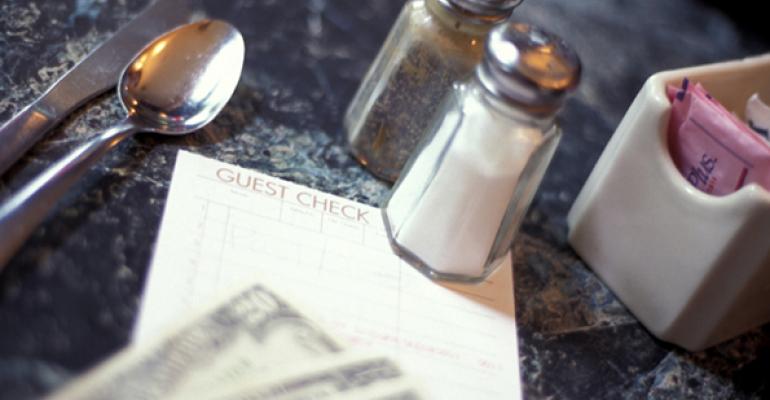Restaurant chain same-store sales rose 2.7 percent in September, marking the seventh month of sales gains in the past eight months, according to the latest NRN–MillerPulse report. It also caps off a third quarter that was the best three-month period for restaurants in terms of sales in more than two years.
“It was a decent end to a decent quarter,” said Larry Miller, founder of the report. As a whole, the industry appears to be on a positive trajectory heading into the end of 2014, Miller said.
Industrywide guest traffic was flat (0.0 percent) in September, a dip compared with August’s minor 0.1 percent increase.
Much of the strength in September sales came in the quick-service sector, which includes several growing fast-casual restaurants, but also chains that have been aggressive in advertising and marketing.
Quick-service restaurants’ same-store sales grew 3.4 percent in September, while traffic rose 0.5 percent.

The notable improvement at QSRs was enough for MillerPulse to lift its industry forecast for the year, to a 1.8-percent increase from its original 1.7 percent. Industry sales are now expected to increase 3.3 percent this year overall, to $514 billion, with sales of $263 billion at QSRs and $251 billion in sales at full-service concepts.
One reason for the improvement in the industry may be falling gas prices. The price of a gallon of gas has dropped considerably compared with last year, which could give some consumers the room they need in their budget to eat out more. According to the AAA, the price of a regular gallon of gas is $3.177 nationwide, compared with $3.347 this time last year.
Still, industry improvement hasn’t been felt broadly. Indeed, quick-service restaurants’ strength in September likely came at the expense of casual dining restaurants.
Casual dining same-store sales rose just 0.8 percent in September. By comparison, they had risen 2.5 percent in August and QSRs’ same-store sales rose 2.9 percent that month, a gap of just 0.4 percent. In other words: The gap between the two sectors widened by 220 basis points in just one month.

Traffic in the sector fell by 2.6 percent, a 220-basis-point decline from August, when traffic at casual dining fell 0.4 percent.
“It’s hard to get excited about casual dining,” Miller said. “The challenge for casual is the same. In the last 36 months, casual may have been ahead of QSR maybe one or two times. It’s nothing new.”
It’s important not to draw too many conclusions from just one report from a single month, but it’s possible that price increases at casual dining chains might have turned some customers off in September.
Rising commodity costs, especially for high-dollar proteins such as beef, pork and chicken, has led many operators to hike prices to maintain margins. Miller said prices at casual dining restaurants have increased on average about 1 percent for the past 12 months, but more recently that price increase has been closer to 2 percent.
Among the different sectors, average check at casual dining chains increased the most, by 3.4 percent. Average check at QSRs increased 2.9 percent, by comparison, while checks at fine dining chains decreased by 0.5 percent.
In an era in which consumers are still strapped for cash, despite employment growth, higher prices are risky, especially in a sector that already faces an uphill battle on the value front, thanks to the tip requirement.
Traffic declines “could be related to pricing,” Miller said. “I get why they’re doing it. The commodity picture is looking a lot worse. But that’s a delicate balance. And traffic hasn’t been great.”
Casual dining chains are also losing customers on the other end of the income spectrum. Fine dining same-store sales rose 4.5 percent, all thanks to 5-percent traffic growth.
None of this is to say that things are hopeless for casual dining—results are improving, Miller said, even if they’ are “less bad.” He likened the current situation to 2002, when casual dining chains were easily outperforming QSRs and people were wondering what was wrong with fast-food chains. Today the situation is reversed, after years of QSRs remodeling restaurants and improving product offerings.
Miller said that casual dining chains should “democratize luxury.”
“People are astute in food preparation and quality,” he said. “If you can bring fine dining quality food to casual dining, you can enhance the asset, and the service experience will take care of itself. The value proposition will change. They’ll be getting a much better value.”
MillerPulse results are based on a monthly survey of operators averaging more than $40 billion in industry sales, representing all regions of the country and across the quick-service, casual-dining and fine-dining segments. Restaurant chains and operators interested in participating in the MillerPulse survey for additional results and insight can register at the MillerPulse website.
Contact Jonathan Maze at [email protected].
Follow him on Twitter: @jonathanmaze





